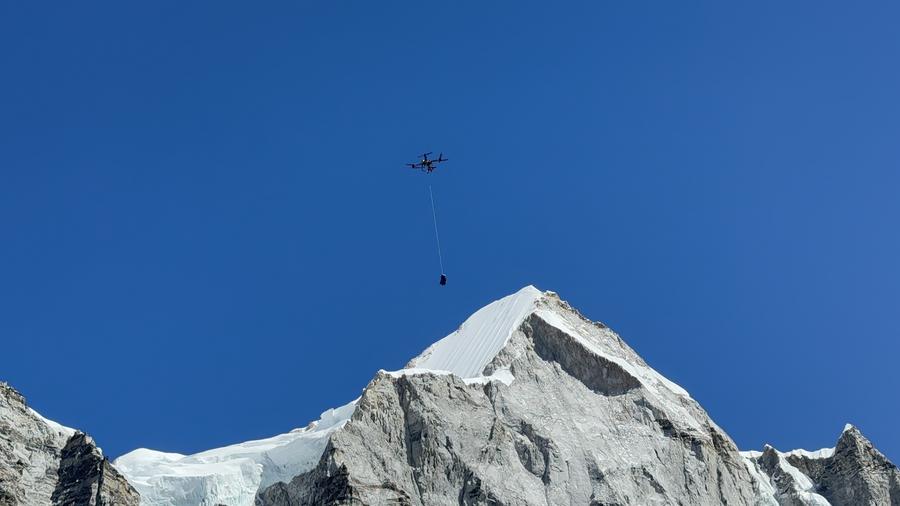
Snapshot taken from a video shows a DJI drone flying over Khumbu Icefall during a delivery test on Mount Qomolangma from the Nepali side, April 30, 2024. (Xinhua)
SHENZHEN, June 7 -- The world's first drone delivery tests on Mount Qomolangma on the Nepal side, conducted by Chinese drone maker DJI, have demonstrated the potential of China's drone industry in facilitating high-altitude mountaineering, emergency rescue, and environmental protection.
"The ability to safely transport equipment, supplies and waste by drone has the potential to revolutionize Mount Qomolangma mountaineering logistics, facilitate trash clean-up efforts and improve safety for all involved," said Christina Zhang, senior corporate strategy director at DJI, which is headquartered in Shenzhen in south China's Guangdong Province.
The April tests used the DJI FlyCart 30 to fly three bottles of oxygen and 1.5 kg of other supplies from the Base Camp (at an altitude of 5,364 meters) to Camp 1 (at about 6,000 meters) of the world's highest peak, and to carry down garbage on the return trip.
During the tests, the DJI FlyCart 30 flew up to 6,191.8 meters on Mount Qomolangma situated on the border of China and Nepal. It was able to carry a 15 kg payload steadily at an altitude of 6,000 meters.
DJI's team set out to solve the transportation bottleneck from Base Camp to Camp 1, separated by the Khumbu Icefall, one of the most dangerous parts of the climb on the southern slope.
An unmodified drone can carry 15 kg between the two camps in 12 minutes for a round trip, day or night. While helicopters can theoretically make the same journey, they are rarely used due to the significant dangers and costs involved.
DJI's delivery drones aim to ease the burden on local Sherpa guides, who repeatedly risk their lives navigating the treacherous Khumbu Icefall, DJI said.
Traditionally, local Sherpa guides are responsible for transporting supplies and clearing trash on Mount Qomolangma, and may need to cross the icefall over 30 times in a season to transport supplies such as oxygen bottles, gas canisters, tents, food, and ropes.
In addition to the safety of climbers and their guides, the environmental issue has also become more prominent in recent years, as more climbers inevitably generate more garbage and waste.
Zhang said that DJI hopes its drones can provide transportation for commercial mountaineering, reduce accidents, and reduce the environmental damage caused by mountaineering activities through garbage removal programs to protect Mount Qomolangma.
Following the tests, a Nepali drone operator has started offering regular drone delivery services on Mount Qomolangma since May 22.
In China, DJI delivery drones have been used on mature commercial climbing routes, such as Mount Gongga, to help transport supplies.
China's delivery drone has broken through the limits of Mount Qomolangma, accumulating valuable experience and data for the development of the country's unmanned aerial vehicle (UAV) industry, said Jin Wei, deputy secretary-general of the China UAV Industry Innovation Alliance.
Due to communication and power limitations, aircraft flying above a certain altitude have been limited to turbine-powered planes or helicopters, which have high purchase and maintenance costs and operational limitations, Jin said.
"I believe more of our UAVs will be used in harsh environments such as high altitude and frigid regions, deserts and oceans, helping us accomplish work and make breakthroughs in more scenarios," Jin said.
"Drones can replace helicopters as a relatively low-risk transport vehicle to supplement supplies on the plateau, which will greatly expand the application space of UAVs," said Cai Yong, a senior engineer at East China Normal University.
The successful high-altitude transport tests will spur the rapid development of upstream and downstream civil drone industries and further expand the application scenarios and market demand of the low-altitude economy, laying the foundation for China's low-altitude economy to gain an early advantage, noted Zhu Hang, a professor at Jilin University's School of Mechanical and Aerospace Engineering.
China's UAV industry has averaged more than 20 percent annual growth in recent years, becoming a new driver for the world's second-largest economy.
In recent years, more electric drones have been used in agriculture and forestry, power line inspection, logistics, and emergency rescue, and each major breakthrough will help save human and material resources and protect the safety of life and property, Jin said.
China's policies on the low-altitude economy, low-altitude airspace management, and application scenario development will surely give a further strong boost to the UAV industry, said Qi Juntong, chairman of drone manufacturer EFY Intelligent Control (Tianjin) Technology Co., Ltd.












